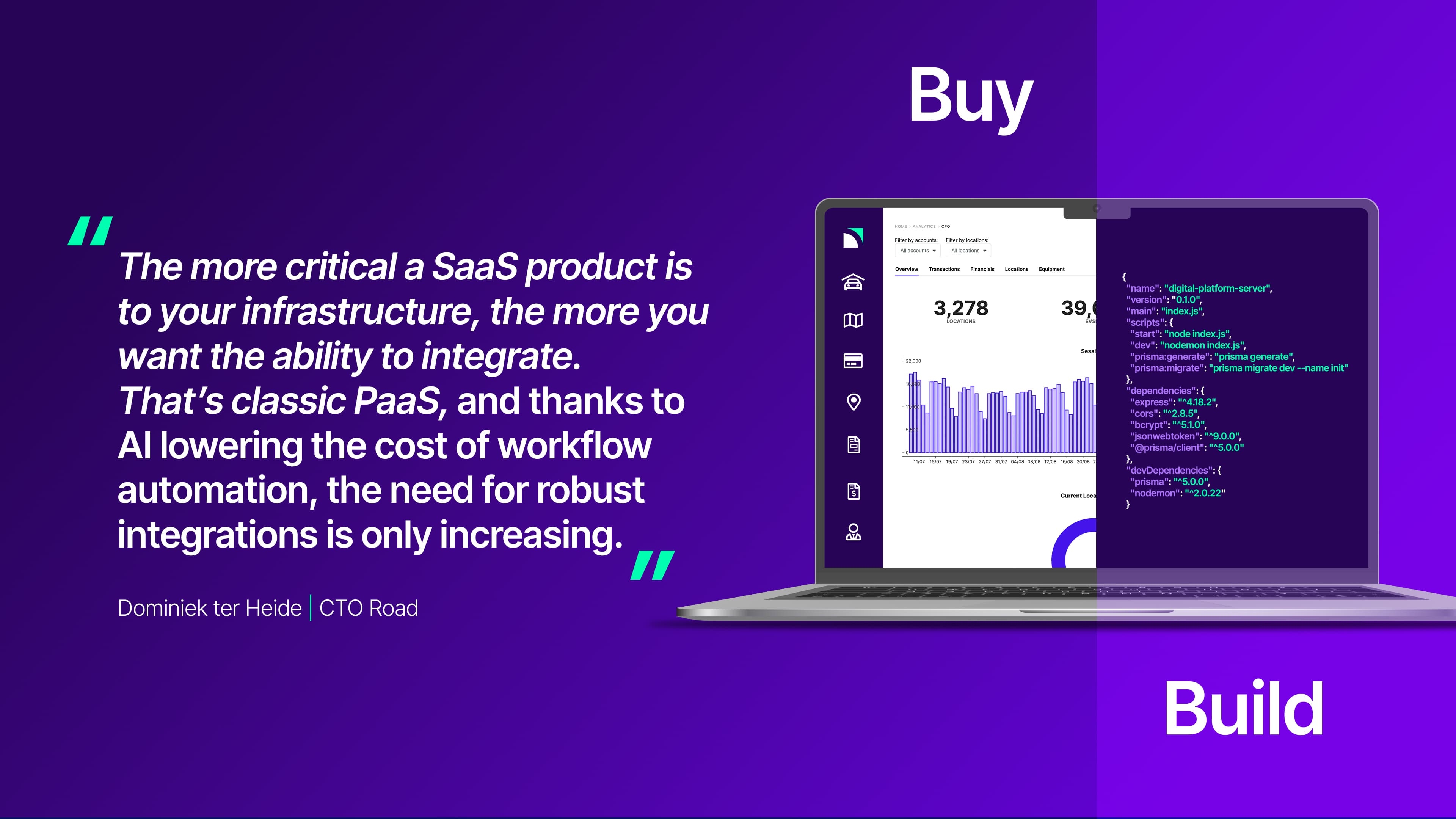Build what matters, buy what works: the hybrid approach
How companies combine speed and control to innovate smarter.
In our earlier explorations of the buy-versus-build dilemma, we examined the contrasting paths of full in-house development and turnkey SaaS adaptation. But there is a middle ground: the hybrid solution. With this, you get to pick and choose which parts you want to build yourself, or which parts you want to buy from a trusted partner.
08 October 2025
At a glance
Buying enables speed and reliability, while building provides control and creativity. A hybrid approach blends the two by letting you source proven components and focus your efforts on what makes your product unique. This way, you accelerate time-to-market, lower risk, and stay in charge of your differentiators. For the final article in the buy vs build discussion, we asked Gina ter Heide and Dominiek ter Heide for their insight on the hybrid solution.
Buying conserves scarce resources, building consumes them. Hybrid ensures you deploy talent and capital where it matters the most. The hybrid model is about balance: you buy the elements that already exist and work well, and you build the pieces that make your product unique. This isn’t black and white. The ideal hybrid customer is a company with established workflows, processes, and dashboards that now wants to add EV charging to its offering. Instead of rebuilding everything, they can pick the missing components – like charge point management – and integrate them via APIs. That way, they can rely on proven expertise from partners in areas such as application management, customer service, or platform stability, while keeping full control of the customer experience that sets them apart.
Having a great idea doesn’t have to mean years of development before it comes to life. You can lean on companies that have already spent years building something to your own advantage for a faster go-to-market pace. And as time goes on, you can even replace the bought solutions with your own built solutions, but in the meantime you already have your company up and running.
For many businesses, the question is not whether to embrace EV charging, but how to do so without disrupting what already works. Building an entirely new system is rarely the smartest move. You’ve invested in established operational frameworks and customer-facing systems – so leverage them. By selecting only the elements you need, such as charge point management, and integrating APIs directly into your existing operations, you can accelerate innovation while keeping focus on your core business.
Companies can create real value when they control the customer journey. A hybrid approach gives them that control — by allowing them to keep their own workflows and processes, while integrating proven solutions for what’s not core.
Why hybrid is the best of both worlds
Joining an existing software market is both exciting and daunting. There are many things to take into consideration and many things you have to know before you even start – but probably won’t find out until after you have started. In fast-moving markets, timing is everything. Hybrid means you’re not waiting years to participate.
Think of it as a box of building blocks. You start out with an existing part and use those to build your own structure. Buying a small part can be anything from core infrastructure to expertise, but you are almost always assured that it works as it has been tested and thus successfully used before. It has already been through the trial and error steps, so you have a track record of operational evidence. For Road, our platform exists out of different modules. Everything that is available within our branded dashboard, is also available via the API.

At Road, we chose the path of building our platform from the ground up. That gave us full control and flexibility, but we also know it’s not the only way forward. Today, Road Private Label enables others to take a hybrid approach. Businesses can “buy” the proven foundation of our platform while still building the custom features, branding, or customer experience that make their service unique. In other words, we have done the heavy lifting, so others can focus on what sets them apart. However, we also understand where not to reinvent the wheel. Rather than building our own Energy Management Solutions, we chose to integrate with proven providers – allowing us to stay focused on our core strengths while leveraging the best the market has to offer.
That is how it works for many of our current customers. We have customers that use the CPMS (charge point management) part fully whitelabel, while the Mobility Service part is fully integrated into their existing infrastructure and processes. There is no need to force customers to choose one way or another, but it is valuable to collaborate strategically, and help their business thrive as this also elevates your own business.
For many of our customers, EV is just one part of a bigger story. They don’t want to start from scratch; they want to extend what already works. That’s where hybrid really proves its value — it gives them the flexibility to do exactly that.
Why hybrid makes sense for your company
You come up with a great idea and find the means to both buy and build it. But what are the benefits from doing this?
- There is a faster go-to-market time. If you already have a solid working foundation, you can start much earlier compared to building from scratch. The risks and early-stage pitfalls have already been tested and removed, so you know the product you’re buying is reliable and superb;
- Cost efficiency in the long run. You avoid reinventing the wheel for core functionalities, focusing resources on what truly differentiates your solution;
- Scalability and stability. The bought components are already tested at scale, giving you a secure base to grow on without worrying about hidden pitfalls;
- Focus on innovation. With the fundamentals taken care of, your team can dedicate time and creativity to building the unique features that set you apart;
- Reduced complexity. Instead of managing everything in-house, you lean on proven systems where it makes sense, making operations smoother;
- Customer trust. By combining a track record of reliability with your own custom-built innovations, you can demonstrate both credibility and ambition;
- Flexibility for the future. A hybrid solution keeps the door open – you can add, swap, or rebuild components as your business evolves.
Balancing the benefits with the risks
The success of a hybrid strategy hinges on deciding which functions to own and which to outsource. Some capabilities, such as customer service, may be too critical to delegate if they define your brand experience. Others can be entrusted to partners without eroding your value proposition. Each choice carries trade-offs, and clarity about your priorities ensures the model works in your favor.
When sourcing a solution for a hybrid approach, always check how mature the API documentation is. Well-documented, stable APIs make integration straightforward and reliable, while poor documentation can slow you down, introduce hidden risks, and create long-term dependency issues.
A hybrid model is only as strong as its partners – and not every provider qualifies as a true PaaS. True PaaS goes beyond exposing APIs; it includes modern, well-documented interfaces, developer tools such as sandboxes and simulators, and even open-source mobile apps to accelerate customisation. Together, these elements lower barriers for teams and ensure hybrid models deliver on their promise of flexibility and speed.
The key is making the right tradeoffs. Be honest about what your unique value proposition is, and double down on that instead of spreading yourself too thin.
Another often-overlooked consideration is the relationship with your provider. While it may seem self-evident, the risk of dependency is real: if your business is built around an external API and that partnership collapses, your entire structure can be compromised. To mitigate this, choose partners whose values and long-term vision align with your own. Invest in transparent communication, set clear expectations, and ensure both parties understand what success looks like – not just technically, but strategically.
Ultimately, hybrid is neither compromise nor shortcut. It is a strategic choice – one that accelerates innovation, safeguards reliability, and empowers businesses to serve customers with both confidence and distinction.


